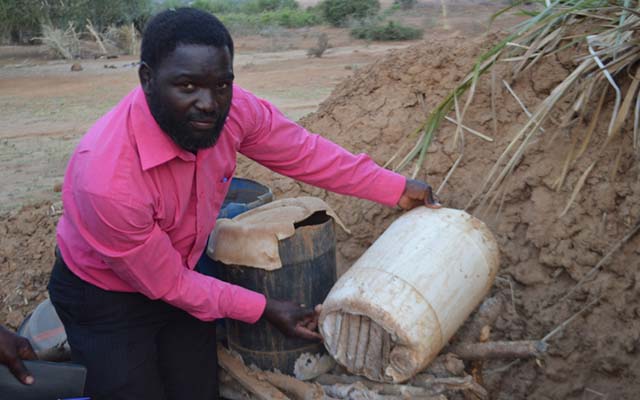Salt off the earth


Councillor Mugido showing the filter bucket
Christopher Charamba: Featurers
It is believed that one of the causes of the collapse of the Great Zimbabwe empire was the shortage of salt in the area. Nyatsimba Mutota was sent on an expedition to look for salt and ended up setting up the Mutapa kingdom further north from Great Zimbabwe. Salt was a highly valued resource at the time, traded for gold, cloth and other items. It was so precious that it was considered taboo to pass salt directly to a person because if it fell to the ground, a conflict was bound to ensue as it could not be retrieved from the dirt.Hence today people believe that if you hand someone salt, the two of you will become enemies. But what if it were possible for one to get salt from the soil?
This is actually what residents of Muzondakaya Village in Chibuwe, Chipinge do. Sixty-year-old Mbuya Sarah Mashonga says she has been making her own salt from the soil since around 1992.
“I started around the time of the economic structural adjustment programme (Esap). My parents and grandparents and great grandparents had been doing this as well and so I learnt it from them.
“The soil here has a high concentration of salt and therefore we are able to make our own,” she said
The salt is produced through a process of filtration.
“It’s a very simple process to make salt and a lot of people in this area do it. First of all, you collect the soil in a bucket. I use a 25-litre one.
“I then transfer the soil into another bucket that will be used for filtering. Once I place the soil in, I then fill the bucket with water,” she said
The filter bucket has a hole at the bottom and a sack in it through which the water is filtered.
“The water drips out of the bucket into another container through the sack. The sack prevents any soil from coming through and what comes out is salty water,” she said.
Mbuya Mashonga said that she leaves the bucket to collect water for a few hours until all the water has filtered through.
“Once the water has collected I then boil it in a big pan. As the water evaporates the salt remains at the bottom of the pan. I then leave it for a while so that it can dry. When that is finished I collect the salt and use it for myself or I sell it.”
Littered around the village are these man made hovels of branches and leaves where the salt manufacturing takes place. On the exterior the filtration machine is set up and on the interior, a fire is made where the salt water is boiled and the final product remains.
A cup of locally produced salt ranges between 20c and 50c in the Muzondakaya Village.
Shamiso Sithole said she learnt how to make salt from her mother-in-law and that she had been doing it since 2005.
“If I use a 25-litre bucket of soil I can fill a five litre bucket of salt. It is very easy because everything we need is right here.
“All that you need to do is collect the soil and make the filter bucket for yourself. We use 25-litre containers and a used sack to make the filter bucket.
“Once you have made your filter bucket by cutting a hole at the bottom and lining it with the sack, the next thing is to make a platform where the bucket and a container can be placed beneath to collect the filtered salt water.
“Finally you need an area where you can boil the water. This must be covered so that the wind does not blow the water or the salt out of the pan,” she said.
Mbuya Liza Bote said that it was poverty that caused people to find this scientific method of making salt.
“In this area people have been making salt in this way for a very long time. My parents and their parents used this kind of salt.
“I believe that it is very good for your health, especially for people with high BP or problems with tonsils. This salt however, is different from the salt you get in the stores.
“For one it is not iodised salt but it does not cause goitre problems.
“The second thing is that it is very strong. Where you would use a teaspoon in your cooking, with this salt half a teaspoon would be more than enough,” she said.

Mbuya Liza Bote and Sarah Mashonga standing by the filtration system.
Ward 20 Councillor Charles Mugido said that the manufacturing of salt was something that many people in the community did as the process was simple and it satisfied their need.
“A lot of women in this community make their own salt and sell it to people within this area and from neighbouring villages.
“The soil is very rich with salt that if you take a bit of it and put it into your mouth you will be able to taste how salty the soil is.
“The production is mainly for local consumption by those who know that it is possible to do so.
“These women sell their salt from about 20c per cup. It is not a lot of money but I would consider it all profit because there are no costs that go into the production process.
“They do not pay for the soil and use materials they find or already have to make the salt,” he said.
According to salt.org, the manufacture of salt is one of the oldest chemical industries.
“The evaporation of seawater is the production method of choice in marine countries with high evaporation and low precipitation rates.
Salt evaporation ponds are filled from the ocean and salt crystals can be harvested as the water dries up.
Sometimes these ponds have vivid colours, as some species of algae and other micro-organisms thrive in conditions of high salinity.
Elsewhere, salt is extracted from the vast sedimentary deposits which have been laid down over the millennia from the evaporation of seas and lakes.
These are either mined directly, producing rock salt, or are extracted in solution by pumping water into the deposit.
One of the largest salt mining operations in the world is at the Khewra Salt Mine in Pakistan.
The mine has 19 storeys, 11 of which are underground, and 400 km of passages. In sub-Saharan Africa, Walvis Bay Salt Holdings (Pty) Ltd, through its various subsidiaries, is the largest producer of solar sea salt.
The group process 50 million tonnes of seawater to produce in excess of 700 000 tonnes of high-quality salt per annum. The total operation covers an area of 4500 hectares.
Feedback: [email protected]










Comments